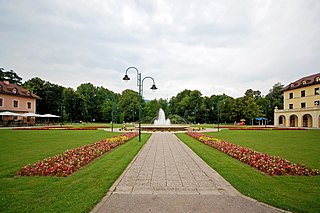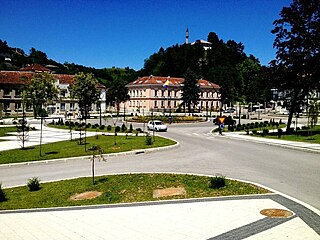
Bosnia and Herzegovina is a country in Southeast Europe, situated on the Balkan Peninsula. It borders Serbia to the east, Montenegro to the southeast, and Croatia to the north and southwest. In the south it has a 20 kilometres long coast on the Adriatic Sea, with the town of Neum being its only access to the sea. Bosnia has a moderate continental climate with hot summers and cold, snowy winters. In the central and eastern regions, the geography is mountainous, in the northwest it is moderately hilly, and in the northeast it is predominantly flat. Herzegovina, the smaller, southern region, has a Mediterranean climate and is mostly mountainous. Sarajevo is the capital and the largest city.

Sarajevo is the capital and largest city of Bosnia and Herzegovina, with a population of 275,524 in its administrative limits. The Sarajevo metropolitan area including Sarajevo Canton, East Sarajevo and nearby municipalities is home to 555,210 inhabitants. Located within the greater Sarajevo valley of Bosnia, it is surrounded by the Dinaric Alps and situated along the Miljacka River in the heart of the Balkans, a region of Southern Europe.

The Zenica-Doboj Canton is one of 10 cantons of the Federation of Bosnia and Herzegovina in Bosnia and Herzegovina. The cantonal seat is the City of Zenica.

Travnik is a town and a municipality in Bosnia and Herzegovina. It is the administrative center of Central Bosnia Canton of the Federation of Bosnia and Herzegovina. It is situated in central Bosnia and Herzegovina, 90 kilometres west of Sarajevo. As of 2013, the town had a population of 15,344 inhabitants, while the municipality had 53,482 inhabitants.

Vogošća is a town and a municipality located in Sarajevo Canton of the Federation of Bosnia and Herzegovina, an entity of Bosnia and Herzegovina. The municipality is located about 6 kilometers north of the city of Sarajevo and is its secondary suburb, after Ilidža. According to the 2013 census, the town has a population of 10,568 inhabitants, with 26,343 inhabitants in the municipality.

Ilidža is a spa town and a municipality located in Sarajevo Canton of the Federation of Bosnia and Herzegovina, an entity of Bosnia and Herzegovina. It has a total population of 66,730 with 63,528 in Ilidža itself, and is a chief suburb of Sarajevo and de facto its neighborhood. It is best known for the Vrelo Bosne spring, as well as the natural environment of its surroundings and historical tradition dating back to Neolithic times. Sarajevo International Airport is located nearby.

The Sarajevo Canton, officially the Canton of Sarajevo, is one of the ten cantons of the Federation of Bosnia and Herzegovina in Bosnia and Herzegovina. Its cantonal seat is the city of Sarajevo, also the capital city of Bosnia and Herzegovina.

Visoko is a city located in the Zenica-Doboj Canton of the Federation of Bosnia and Herzegovina, an entity of Bosnia and Herzegovina. As of 2013, the municipality had a population of 39,938 inhabitants with 11,205 living in Visoko town. Located between Zenica and Sarajevo, Visoko lies where the river Fojnica joins the Bosna.

The economy of Sarajevo is based largely on industries such as manufacturing and tourism. Sarajevo is economically one of the strongest regions of Bosnia and Herzegovina. As the center of various levels of area politics, many Sarajevo citizens also work in government. A number of local and international companies are present in the city and contribute to its economic health.

Cazin is a city located in Una-Sana Canton of the Federation of Bosnia and Herzegovina, an entity of Bosnia and Herzegovina. It is situated in northwest Bosnia and Herzegovina in the Bosanska Krajina region, near the border with Croatia. As of 2013, it has a population of 66,149 inhabitants.

Gradiška, formerly Bosanska Gradiška, is a city of northwestern Bosnia and Herzegovina, located in Republika Srpska entity. As of 2013, it has a population of 51,727 inhabitants, while the city of Gradiška has a population of 14,368 inhabitants.

Živinice is a city located in Tuzla Canton of the Federation of Bosnia and Herzegovina, an entity of Bosnia and Herzegovina. It is located in northeastern Bosnia and Herzegovina, south of Tuzla. As of 2013, it has a population of 57,765 inhabitants.

Istočno Sarajevo is a city in Bosnia and Herzegovina, located in the Republika Srpska entity. It consists of a few suburban areas located south of pre-war Sarajevo which are now included in the Republika Srpska entity, and newly built areas.

Sokolac is a municipality of the city of Istočno Sarajevo of Bosnia and Herzegovina, located in Republika Srpska entity. As of 2013, it has a population of 12,021 inhabitants, while the town of Sokolac has a population of 5,919 inhabitants.

Ljubinje is a town and municipality of Bosnia and Herzegovina, located in the Republika Srpska entity. It is situated in south-eastern part of Herzegovina region. As of 2013, the town has a population of 2,744 inhabitants, while the municipality has 3,511 inhabitants.

Central Bosnia is a central subregion of Bosnia, which consists of a core mountainous area with several basins, valleys and mountains. It is bordered by Bosnian Krajina to the northwest, Tropolje to the west, Herzegovina to the south, Sarajevo to the east and Tuzla to the northeast. It is a part of the Federation of Bosnia and Herzegovina and is divided between the Central Bosnia Canton and the Zenica-Doboj Canton, with a population of around 800,000. The largest city in the region is Zenica, with the Sarajevo-Zenica basin being the most densely populated area. Its highest peaks are Vranica, Šćit and Bitovnja.

The COVID-19 pandemic in Bosnia and Herzegovina was a part of the worldwide pandemic of coronavirus disease 2019 caused by severe acute respiratory syndrome coronavirus 2. The virus was confirmed to have reached Bosnia and Herzegovina on 5 March 2020, when a patient in Banja Luka, who had travelled to Italy, tested positive. Later on the same day, a second case, who was the son of the first case, was reported. On 21 March, the first death in the country from COVID-19 was announced in a hospital in Bihać. The patient was an elderly woman who had been hospitalized two days before.
Events in the year 2020 in Bosnia and Herzegovina.


















